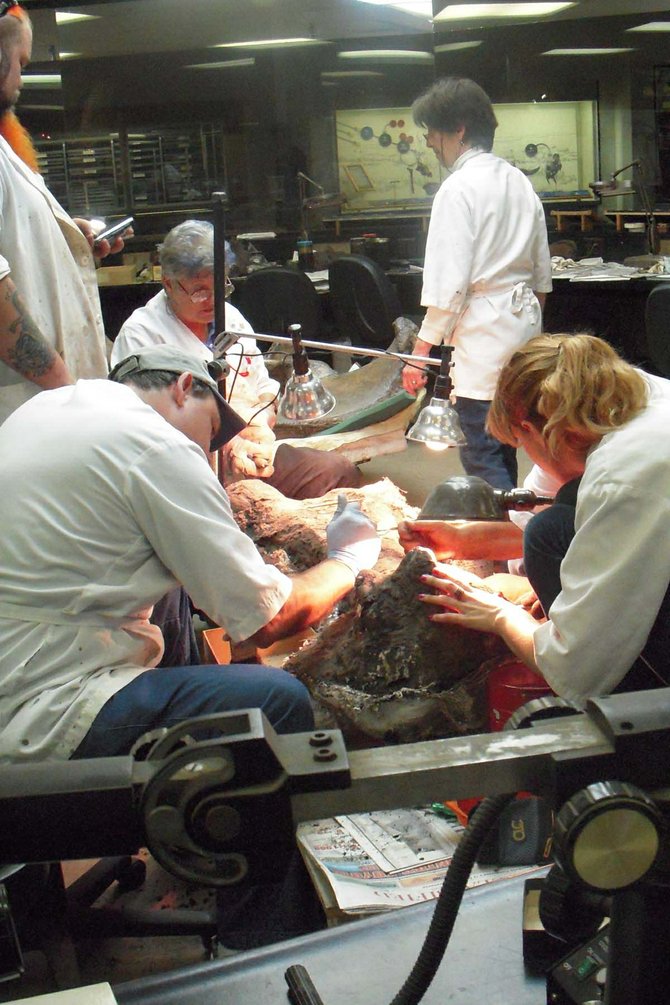 Facebook
Facebook
 X
X
 Instagram
Instagram
 TikTok
TikTok
 Youtube
Youtube

Things I’ve learned at Rancho La Brea:
1.) La Brea means “the tar” in Spanish, so if you say The La Brea Tar Pits, you’re really saying The The Tar Tar Pits
2.) The fossils found in the Tar Pits are from the Ice Age
3.) No dinosaur bones have ever been found at the Tar Pits because dinosaurs were extinct 65 million years before the Ice Age (and L.A. was underwater during the dinosaur years)
4.) Dinosaur books, toys and other dino-phernalia are still hot sellers in the museum’s gift shop
5.) La Brea docents don’t necessarily appreciate questions about dinosaurs.
Located on Wilshire Blvd in the Miracle Mile district, the La Brea Tar Pits is a smelly, wondrous and fascinating place. Tar continues to ooze up in spots around Hancock Park, where the odor of asphalt hangs heavy in the air.
On a recent trip, we followed the walking path through Hancock Park around the lake, where we watched shiny bubbles of methane simmer and pop across the oil-slick water’s surface. Inside the Page Museum's "fishbowl," researchers busily worked on a mammoth femur. The nearly intact skeleton of the mammoth, nicknamed Zed, was discovered during a recent excavation. We watched the almost obsessive workings of the research team as they dug, scraped and brushed away at the asphalt-encrusted bones of the beast.
Perhaps my favorite part of the museum was the short movie about how scientists presume thirsty water-seeking animals became trapped in the tar, their cries for help attracting predators who in turn got stuck in the muck to die alongside their prey. The strangely intense movie can make small children cry.
Also fascinating: the wall of hundreds upon hundreds of Dire wolf skulls, and Petri dishes of teeny-weeny mouse fossils.


Things I’ve learned at Rancho La Brea:
1.) La Brea means “the tar” in Spanish, so if you say The La Brea Tar Pits, you’re really saying The The Tar Tar Pits
2.) The fossils found in the Tar Pits are from the Ice Age
3.) No dinosaur bones have ever been found at the Tar Pits because dinosaurs were extinct 65 million years before the Ice Age (and L.A. was underwater during the dinosaur years)
4.) Dinosaur books, toys and other dino-phernalia are still hot sellers in the museum’s gift shop
5.) La Brea docents don’t necessarily appreciate questions about dinosaurs.
Located on Wilshire Blvd in the Miracle Mile district, the La Brea Tar Pits is a smelly, wondrous and fascinating place. Tar continues to ooze up in spots around Hancock Park, where the odor of asphalt hangs heavy in the air.
On a recent trip, we followed the walking path through Hancock Park around the lake, where we watched shiny bubbles of methane simmer and pop across the oil-slick water’s surface. Inside the Page Museum's "fishbowl," researchers busily worked on a mammoth femur. The nearly intact skeleton of the mammoth, nicknamed Zed, was discovered during a recent excavation. We watched the almost obsessive workings of the research team as they dug, scraped and brushed away at the asphalt-encrusted bones of the beast.
Perhaps my favorite part of the museum was the short movie about how scientists presume thirsty water-seeking animals became trapped in the tar, their cries for help attracting predators who in turn got stuck in the muck to die alongside their prey. The strangely intense movie can make small children cry.
Also fascinating: the wall of hundreds upon hundreds of Dire wolf skulls, and Petri dishes of teeny-weeny mouse fossils.
Comments